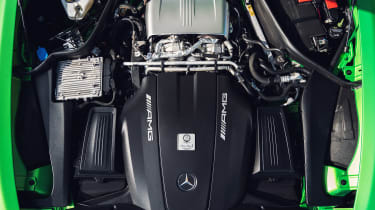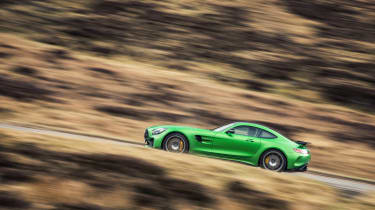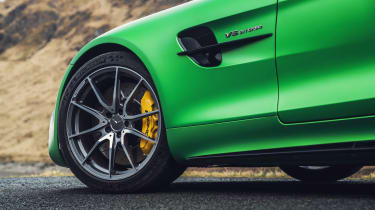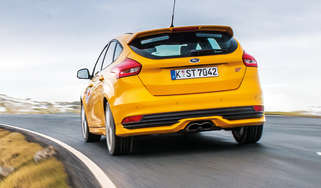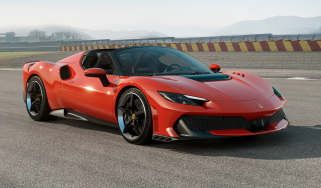Mercedes-AMG GT R (2016-2022) review
AMG found a deeper talent with the GT R, coming up with a true Porsche 911 GT3 rival
The Mercedes-AMG GT was tasked with raising Merc’s game to fight Porsche’s 911 when it was revealed back in 2014. For the first time in decades, the two-seater GT was a direct and unashamed attempt to claim some ground against a sports car that Porsche had laid claim to for over 60 years. Yet not just satisfied to go after Carreras, AMG also had its eyes fixed on the GT3 of which spawned the GT R, a more powerful, focused and expensive track day car.
Like all GTs, the heart of the GT R is AMG’s stonking M178 twin-turbo 4-litre V8. This engine might feel familiar thanks to its use across a whole generation of AMG models from C-classes to G-classes, but for the GT it was a specific iteration designed for AMG’s supercar and motorsport programs. There were a whole range of small detail changes, but the most obvious difference was its dry-sump layout, a feature that allowed AMG to mount it much lower in the chassis than other AMG models.
Given its placement at the upper end of the AMG range (later usurped by the AMG GT Pro and GT Black Series), the R increased its peak power compared to the standard GT and GT S to 577bhp, together with 516lb ft of torque from just 1900rpm right through to 5500rpm.
To achieve this, the turbo internals had been modified, engine mapping revised and boost pressure increased from 1.2bar to 1.35. AMG’s engineers have also altered the compression ratio, refined the exhaust port design, changed the way the boost pressure builds and fitted a new dual-mass flywheel that’s 0.7kg lighter than that fitted to the GT S – all with the aim of sharpening throttle response.
More reviews
Group tests
- Porsche 911 GT3 RS (991.2) v Mercedes-AMG GT R Pro – battle of the road-racers
- Mercedes-AMG GT 63 v Porsche 911 Turbo S: all-wheel drive GTs go head-to-head
Reviews
- Mercedes-AMG GT63 Pro 2025 review – a four-seat Porsche 911 GT3 rival?
- Mercedes-AMG GT 63 S E Performance 2025 review – testing the fastest AMG ever
- Mercedes-AMG GT 63 2024 review – is AMG’s coupe finally a Porsche 911 beater?
- Mercedes-AMG GT R (2016-2022) review
- Mercedes-AMG GT Black Series 2021 review – crosshairs pointed at 911 GT2 RS
> Porsche 911 GT3 (992) review
The transmission is the familiar seven-speed dual-clutch paddleshift gearbox fitted to the rest of the GT range, albeit with a taller first gear, shorter sixth gear and a lowered final-drive ratio for increased in-gear urgency. Top speed is 199mph and 0-62mph takes just 3.6sec.
Yet beyond the powertrain, the GT R was really about detailed engineering, with painstaking attention paid to the chassis, aerodynamics, weight reduction and structural rigidity.
Hidden beneath the skin are many trick components made from exotic lightweight materials. Carbonfibre is used for the prop shaft and torque tube, with magnesium used for part of the front structure. The battery is lithium-ion.
The most obvious changes compared to the ‘narrow-body’ GTs are those made to the bodywork. Using a mixture of aluminium and carbonfibre, the front and rear wings have been stretched by 46mm and 57mm respectively to cover the GT R’s wider track. The nose was the first AMG to gain the now trademark Panamericana grille, while the rear end wears an adjustable, full-width wing. In addition, active aerodynamics control a section of the underbody beneath the engine bay that automatically lowers 40mm (at 50mph in Race mode and 75mph in Comfort, Sport and Sport+), to create a venturi effect that reduces front-axle lift by some 40kg at 155mph as well as feeding the large double diffuser at the rear. In total, the R’s aero package generates 155kg more downforce at maximum speed than the regular AMG GT.
The suspension features adaptive coil-over dampers, which can be run in Comfort, Sport and Sport+ settings. Uniball spherical bearings are used to locate the lower rear wishbones for more precise control. There’s also a thicker tubular rear anti-roll bar.
It also preceded Porsche’s use of a rear-wheel steering system in one of its track-focused models, a feature that’s now common right across the market. Up to a speed of 60mph the rear wheels are turned in the opposite direction to the front wheels, increasing agility by effectively shortening the car’s wheelbase. Above 60mph the rear wheels turn in the same direction as the fronts to increase stability.
Also new to the R was a nine-way traction-control system, which is controlled via a yellow rotary switch on the dashboard. It looks incongruous until you appreciate it’s very similar to that found in the GT3 race car. This system is accessed once you disable the regular three-stage ESP. This car being an AMG model, you can work your way through the usual suite of driving modes to tailor engine response, damping and transmission characteristics via Comfort, Sport, Race, Race+ and Individual modes. And, of course, there’s a switchable exhaust mode to bring the thunder on-demand via the R’s striking triple-exit system, which features a large central tailpipe flanked by a pair of smaller outlets.
> Porsche 911 GT3 RS (991.2) review
Other highlights include the lightweight forged aluminium wheels and ceramic composite braking system. Featuring 402mm front and 360mm rear discs, the braking system offers longer service life, greater resistance to fade and a significant 15kg saving in unsprung weight.
As AMG’s take on a 911 GT3, you’d expect the R to look the part, but crucially it feels it, too. The manually-adjustable seats grip you tight and place you low in the car, but you still get a great view down the sharply sculpted bonnet. Like with all AMGs, the engine starts with a boom, pulses at idle and roars with every prod of the throttle. It’s a loud and extroverted machine.
On track, it’s a car that’s to be enjoyed rather than feared. With Race mode selected and the ESP system active, in its most relaxed setting, you can work the GT R’s throttle hard with confidence. It’s bullet-fast out of the corners and down the straights, aided by a DCT transmission that delivers clean upshifts and snappy downshifts, complete with a fusillade of bangs and crackles through the exhaust.
> Also read - Mercedes-AMG GT full review
However, it’s the grip, traction and balance that are truly impressive. The steering weight is moderate, perhaps even a little lighter than you expect, but you have a genuine sense of connection with the R’s front end. It finds terrific bite but never feels overly responsive, so you can really lean on it. And because there’s absolute unity between the front and rear ends of the car – something the GT S struggles to deliver – you can do so without fear of the tail struggling to cope with the rate of response.
It resists understeer brilliantly in the tighter corners, just pushing as you chase the throttle, but then neutralising as you power from apex to exit. The ESP just nibbles away if you really push things, but it’s not too intrusive. It’s equally adept through medium and high-speed corners, with exceptional grip matched by steadfast stability in direction changes and awkward braking areas where you also need to steer the car.
Subsequent lapping sessions with ESP and traction control fully disabled reveal even greater ability. Until this point, AMG products always tended to struggle to deploy all their performance on track. Traction is limited, stability compromised and tyres worked to a frazzle in a handful of laps. The GT R is different. Very different. It finds so much grip on the way into corners and so much drive on the way out that you really can enjoy working it to and beyond its limits, as you would with a 911 GT3.
When it eventually slides, it breaks away progressively (despite the considerable speed it's carrying and lateral forces it's generating) and can be held at modest angles that are hugely satisfying while maintaining your corner speed. Where AMGs always have a tendency to feel like blunt instruments on track, the GT R is a precision tool.
Out on the road the GT R feels hardcore. That’s as you’d hope, but it’s a very firm car, even in Comfort mode. On the plus side that means it’s sharp as a flick knife, cutting a clean line through the corners and revelling in rapid direction changes, yet thanks to the rear-steer it always feels more controlled. There’s greater feel and connection, too, so tapping into this dynamism and agility doesn’t feel like a leap of faith. It’s fun and blisteringly fast, but doesn’t rely on pure speed to deliver a memorable driving experience.
The car copes well with compressions, but has a tendency to skip across sharp bumps and crests, especially when you’re accelerating hard. Hit the wrong combination of road imperfections and it feels a bit like a skimming stone. Not crashing from bump to bump, but just struggling for rear wheel travel. You feel it and hear it in the slight rise and fall in the engine note as the rear tyres momentarily fight for traction.
On the smoothest sections of tarmac the Sport setting is good and delivers really tight body control, but on the whole Comfort is plenty stiff enough. On tighter, more marginal roads it can all be a bit much due to not only the stiff setup, but also the GT R’s physical size. It’s just too wide to really shine on the sort of roads that a GT3 shines on.
Price and rivals
By the closing of production in 2022, the GT R’s price was listed at £158,285, getting closer to £180,000 when you add worthwhile options such as the composite brakes, forged wheels and lairy paint.
Its most obvious rival at launch was the Porsche 991 GT3, a car that was continually refined over its subsequent generations to be a constant benchmark that was always just out of reach from AMG. The later 992 took things even more seriously, and added a new level of performance and capability that did start to show the AMG up. Similar money will also buy anything from an Audi R8 V10 Performance Quattro to McLaren’s range of 570 and 600 models, the latter 600LT being of particular brilliance.
Yet AMG’s flagship is every bit as desirable as any of them, punches as hard and delivers abundant thrills in its own distinct way. It proved that AMG had found its groove, a super sports car that wasn’t dominated by its engine – brilliant though it is – but rather the way it syncs with the chassis and systems.



